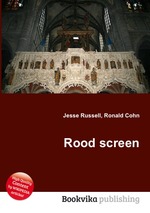Rood screen
Jesse Russell Ronald Cohn
бумажная книга
High Quality Content by WIKIPEDIA articles! The rood screen (also choir screen, chancel screen, or jube) is a common feature in late medieval church architecture. It is typically an ornate partition between the chancel and nave, of more or less open tracery constructed of wood, stone, or wrought iron. The rood screen would originally have been surmounted by a rood loft carrying the Great Rood, a sculptural representation of the Crucifixion. In English, Scots, and Welsh cathedral, monastic, and collegiate churches, there were commonly two transverse screens, with a rood screen or rood beam located one bay west of the pulpitum screen, but this double arrangement nowhere survives complete, and accordingly the preserved pulpitum in such churches is sometimes referred to as a `rood screen`. At Wells Cathedral the medieval arrangement was restored in the 20th century, with the medieval strainer arch supporting a rood, placed in front of the pulpitum and organ.


